|
|
|
Sort Order |
|
|
|
Items / Page
|
|
|
|
|
|
|
| Srl | Item |
| 1 |
ID:
117591
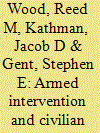

|
|
|
|
|
| Publication |
2012.
|
| Summary/Abstract |
Research has begun to examine the relationship between changes in the conflict environment and levels of civilian victimization. We extend this work by examining the effect of external armed intervention on the decisions of governments and insurgent organizations to victimize civilians during civil wars. We theorize that changes in the balance of power in an intrastate conflict influence combatant strategies of violence. As a conflict actor weakens relative to its adversary, it employs increasingly violent tactics toward the civilian population as a means of reshaping the strategic landscape to its benefit. The reason for this is twofold. First, declining capabilities increase resource needs at the moment that extractive capacity is in decline. Second, declining capabilities inhibit control and policing, making less violent means of defection deterrence more difficult. As both resource extraction difficulties and internal threats increase, actors' incentives for violence against the population increase. To the extent that biased military interventions shift the balance of power between conflict actors, we argue that they alter actor incentives to victimize civilians. Specifically, intervention should reduce the level of violence employed by the supported faction and increase the level employed by the opposed faction. We test these arguments using data on civilian casualties and armed intervention in intrastate conflicts from 1989 to 2005. Our results support our expectations, suggesting that interventions shift the power balance and affect the levels of violence employed by combatants.
|
|
|
|
|
|
|
|
|
|
|
|
|
|
|
|
| 2 |
ID:
173822
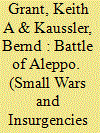

|
|
|
|
|
| Summary/Abstract |
Civilian victimization, whether deliberate or collateral, is a common occurrence in civil war. This study investigates patterns of civilian victimization during the 5-year Battle of Aleppo, a major campaign of the Syrian Civil War in which there were 24,462 documented civilian fatalities. We argue that the primary belligerents and their external patrons respond to shifts in the conflict’s strategic balance of power, employing more indiscriminate force when their opponent is gaining advantage, resulting in higher civilian fatalities. A quantitative analysis of the Battle of Aleppo models weekly civilian fatalities as a function of belligerents’ conflict initiation interacted with regime and rebel offensives aimed at shifting the status quo. While regime-initiated conflict events appear to be the primary determinant of civilian fatalities, our analysis finds that conflict events initiated by the opposition forces during periods of rebel offensive gains are associated with fewer civilian casualties, while pro-government external intervention during rebel offensives is associated with elevated civilian fatalities. We expand on these findings through a focused case study of third party intervention during the final year of the battle, with emphasis on the Russian intervention on behalf of the Syrian Regime that broke the opposition’s final counteroffensive.
|
|
|
|
|
|
|
|
|
|
|
|
|
|
|
|
| 3 |
ID:
183021


|
|
|
|
|
| Summary/Abstract |
How does combat affect insurgent violence against civilians? Existing studies emphasize the role of combat outcomes, but have not explored the direct effects of various combat events. This article argues that one such event, government attacks on the rebels, has a positive effect on insurgent violence that stems from the logic of guerrilla warfare. In guerrilla wars, government forces tend to rely on informants in finding the insurgents. Their attacks therefore often evince civilian denunciation. To deter future denunciations, the rebels have incentives to subsequently punish the suspected or known denunciator. This argument is probed using detailed original data from Nepal’s Maoist insurgency. A panel analysis shows that government attacks were positively associated with rebel violence against civilians, and especially with violence against suspected informants. Process-tracing evidence further supports the argument, suggesting that the rebels used violence strategically to prevent information leaks and government attacks.
|
|
|
|
|
|
|
|
|
|
|
|
|
|
|
|
| 4 |
ID:
140451


|
|
|
|
|
| Summary/Abstract |
Tajikistan experienced a brutal civil war shortly after independence, in which an estimated 50,000 people died. Yet the scope, patterns and effects of civilian victimization in Tajikistan remain under-examined. This article explores two key questions: (1) What types of civilian victimization were utilized by the war's victor, the Popular Front of Tajikistan (PFT)? (2) What were the strategic effects and outcomes of civilian victimization by the PFT? The aim is to disaggregate civil war violence in Tajikistan and enable new avenues of research into its patterns and effects. The article's key findings are that civilians were victimized primarily through targeted violence and displacement, and that victimization was generally a successful strategy for the PFT.
|
|
|
|
|
|
|
|
|
|
|
|
|
|
|
|
| 5 |
ID:
184190
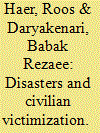

|
|
|
|
|
| Summary/Abstract |
How do natural disasters affect the treatment of civilians by non-state actors? On the one hand, conflict literature argues that adverse shocks influence the strategic interplay between rebel groups and the government, potentially increasing the level of violence against civilians. On the other hand, sociological research on natural disasters argues that they increase social integration and cooperation and are thus expected to reduce the risk of violent behaviour. In this study, we contend that the dynamics of violence against civilians are different in the short term and long term after a disaster strikes. We argue that natural disasters lead to a decrease in violence against civilians perpetrated by rebel groups in the short run. However, over time this temporary improvement in social integration starts to decline, increasing the level of civilian victimization. To examine this potential temporal dynamic, we combine georeferenced information on one-sided violence (Armed Conflict Location & Event Data; ACLED) and data on disasters (Emergency Event Database; EM-DAT). Our results confirm the expected dynamic effects. This research has important implications for our understanding of how disasters can influence the relationship between civilians, rebel groups, and governments.
|
|
|
|
|
|
|
|
|
|
|
|
|
|
|
|
| 6 |
ID:
156919
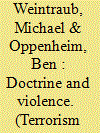

|
|
|
|
|
| Summary/Abstract |
Military theorists and practitioners have long argued that training shapes how combatants treat civilians during war. Yet there is little systematic evidence regarding the impact of training on wartime behavior, and almost none for non-state armed groups, despite the fact that such groups intensively train their fighters in order to shape their behavior towards civilian populations. This article argues that among insurgent groups that emphasize the strategic and tactical importance of restraint towards civilian populations, political training can reduce civilian killings. We test the observable implications of our theory in the case of Colombia, using survey data on former Revolutionary Armed Forces of Colombia (FARC) insurgents and sub-national data on civilian killings. We find support for our hypothesis, with results that are robust to a range of model specifications and controls, including alternate sources of combatant discipline and obedience, such as military training and punishment.
|
|
|
|
|
|
|
|
|
|
|
|
|
|
|
|
| 7 |
ID:
174769


|
|
|
|
|
| Summary/Abstract |
What causes civilian victimization in conventional civil wars and in conventional wars that experience insurgencies? The authors argue that a key driver of civilian victimization is the vulnerability of the incumbent forces, specifically when the conflict’s front line is shifting. Vulnerability is a function of informational and logistical challenges: when the front line is moving, incumbents face increased informational uncertainty and unstable supply chains that augment their vulnerability. Thus, incumbents will increase the use of civilian victimization in response to a scarcity of high-quality information on the location and identity of insurgents, to limit possible information leaks, and to contain supply disruption and logistics support to adversaries. The authors support their argument using matched difference-in-differences analyses of original subnational data on Nazi-Fascist violence in World War II Italy (1943–1945) and qualitative evidence.
|
|
|
|
|
|
|
|
|
|
|
|
|
|
|
|
| 8 |
ID:
157907


|
|
|
|
|
| Summary/Abstract |
Previous research demonstrates that refugee populations can threaten the security of receiving countries. This study, in contrast, seeks to examine the physical security challenges refugees face in host states. It utilizes a new, geographically referenced data set on subcountry refugee demographics to test the hypothesis that locations home to larger refugee populations are more likely to experience one-sided attacks by conflict actors. Results demonstrate that refugee accommodation is a significant predictor of one-sided violence in Africa. In particular, combatants commit significantly more acts of violence against civilians in locations home to larger numbers of self-settled refugees compared to other locations. These findings suggest that scholars and practitioners account for possible dangers presented by refugee flows and threats to refugees simultaneously.
|
|
|
|
|
|
|
|
|
|
|
|
|
|
|
|
| 9 |
ID:
161740


|
|
|
|
|
| Summary/Abstract |
Can International Criminal Court (ICC) interventions in ongoing conflicts help curtail war crimes and civilian abuses that are being actively perpetrated? The court has increasingly intervened in such cases, partly with the intention of using its prosecutorial power to stop ongoing abuses. Yet, while much has been said about the court's potential for deterrence, little attention has been devoted to its compellent effects. Drawing on insights from the literature on coercive diplomacy, strategic bargaining, and civilian victimization, this article clarifies and critically assesses the logic of ICC compellence in cases of ongoing civilian violence. I argue that some forms of ICC intervention have compellent potential but are inherently limited. Specifically, I show why threats of prosecution, rather than actual indictments, are far more likely to be effective at curtailing violence, but also how their effective application is highly constrained by the court's own core normative principles, rules, and structures. While some see the main problem as weak enforcement—something that can be remedied with greater political will—there is a more fundamental impediment: to compel effectively, the court must carefully coordinate its actions with other states’ diplomatic and military efforts or allow itself to be used strategically by states pursuing diplomatic and military measures to curtail violence—positions that are incompatible with the court's statutory obligations and its very ethos as an independent and impartial nonstate judicial institution.
|
|
|
|
|
|
|
|
|
|
|
|
|
|
|
|
| 10 |
ID:
100396
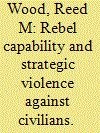

|
|
|
|
|
| Publication |
2010.
|
| Summary/Abstract |
This article explores the strategic motivations for insurgent violence against civilians. It argues that violence is a function of insurgent capacity and views violence and security as selective benefits that insurgents manipulate to encourage support. Weak insurgent groups facing collective action problems have an incentive to target civilians because they lack the capacity to provide sufficient benefits to entice loyalty. By contrast, stronger rebels can more easily offer a mix of selective incentives and selective repression to compel support. This relationship is conditioned by the counterinsurgency strategies employed by the government. Indiscriminate regime violence can effectively reduce the level of selective incentives necessary for insurgents to recruit support, thus reducing their reliance on violence as a mobilization tool. However, this relationship only holds when rebels are sufficiently capable of credibly providing security and other incentives to civilian supporters. These hypotheses are tested using data on one-sided violence from the Uppsala Conflict Data Program. The statistical analysis supports the hypothesis that comparatively capable insurgents kill fewer civilians than their weaker counterparts. The results also suggest a complex interaction between insurgent capability and government strategies in shaping insurgent violence. While weaker insurgents sharply escalate violence in the face of indiscriminate regime counterinsurgency tactics, stronger groups employ comparatively less violence against civilians as regime violence escalates.
|
|
|
|
|
|
|
|
|
|
|
|
|
|
|
|
| 11 |
ID:
079921
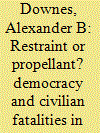

|
|
|
|
|
| Publication |
2007.
|
| Summary/Abstract |
This article investigates the effect of regime type on the number of civilian fatalities that states inflicted in interstate wars between 1900 and 2003. As opposed to several previous studies, the author finds little support for normative arguments positing that democracies kill fewer civilians in war. In fact, the author finds that democracies are significantly more likely than nondemocracies to kill more than fifty thousand noncombatants. Democracies also kill more civilians when they are involved in wars of attrition and kill about as many (and perhaps more) noncombatants than autocracies in such wars. These findings provide qualified support for institutional arguments about democratic accountability. Other implications of the institutional view, however, are not upheld, such as the argument that democracies select easy wars that should result in few civilian casualties because they are won quickly and decisively. Finally, democracies do not appear to kill fewer civilians in more recent wars
|
|
|
|
|
|
|
|
|
|
|
|
|
|
|
|
| 12 |
ID:
141227
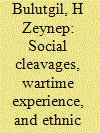

|
|
|
|
|
| Summary/Abstract |
What explains ethnic cleansing? Recent research has used systematic evidence to explore the causes of civilian victimization and mass killings. Yet, comparable studies that focus on ethnic cleansing are still rare. This article conceptualizes ethnic cleansing as a group-level phenomenon that is distinct from civilian victimization or mass killings and studies its causes by using systematic evidence from Europe 1900–2000. The article makes two theoretical moves. First, it highlights the salience of non-ethnic cleavages such as social class as a background condition that has the ability to hinder ethnic cleansing. Second, it distinguishes between two causal mechanisms, one that considers wars as ‘strategic environments’ and the other as ‘transformative experiences’, that relate to the proximate causes of ethnic cleansing. Using original data from 20th-century Europe, the empirical analysis offers two main findings. First, it shows that salient social cleavages, measured through levels of land inequality, political competition, and support for left-wing parties, substantially decrease the risk of ethnic cleansing. Second, the analysis suggests that the arguments that underscore psychological mechanisms related to wartime experiences provide a better explanation for ethnic cleansing than the arguments that emphasize the role of strategic wartime aims. This finding is further supported by a brief discussion of key cases in which both causal mechanisms predict ethnic cleansing. The results highlight the importance of treating ethnic cleansing as a conceptually separate phenomenon and offer implications for the debate on democracy and mass ethnic violence.
|
|
|
|
|
|
|
|
|
|
|
|
|
|
|
|
| 13 |
ID:
157581


|
|
|
|
|
| Summary/Abstract |
Why do some civil wars feature the mass killing of civilians while others do not? Recent research answers this question by adopting a ‘varieties of civil war’ approach that distinguishes between guerrilla and conventional civil wars. One particularly influential claim is that guerrilla wars feature more civilian victimization because mass killing is an attractive strategy for states attempting to eliminate the civilian support base of an insurgency. In this article, I suggest that there are two reasons to question this ‘draining the sea’ argument. First, the logic of ‘hearts and minds’ during guerrilla wars implies that protecting civilians – not killing them – is the key to success during counterinsurgency. Second, unpacking the nature of fighting in conventional wars gives compelling reasons to think that they could be particularly deadly for civilians caught in the war’s path. After deriving competing predictions on the relationship between civil war type and mass killing, I offer an empirical test by pairing a recently released dataset on the ‘technology of rebellion’ featured in civil wars with a more nuanced dataset of mass killing than those used in several previous studies. Contrary to the conventional wisdom, I find that mass killing onset is more likely to occur during conventional wars than during guerrilla wars.
|
|
|
|
|
|
|
|
|
|
|
|
|
|
|
|
| 14 |
ID:
165454
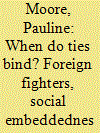

|
|
|
|
|
| Summary/Abstract |
How do foreign fighters affect civilian victimization in the civil wars they join? Scholars of civil war have gone to great lengths to explain why states and insurgent groups victimize civilians, but they have not explicitly examined the impact of foreign combatants. Furthermore, while contemporary conventional wisdom attaches an overwhelmingly negative connotation to foreign fighters, history shows that the behavior of those who travel to fight in wars far from home varies significantly, especially when it comes to interacting with local populations. To address this variation, I demonstrate how differences in the embeddedness of foreign fighter populations combine with incentives that foreign fighters face to remain in the conflict zone over the long term to shape tendencies towards civilian victimization. My findings from an analysis of insurgent groups from 1990 to 2011 suggest that, overall, foreign fighters lead to escalations in violence against civilians. When comparing across groups that recruit foreign fighters, however, levels of violence differ depending on foreign fighter populations’ coethnicity to the rebel groups they join, and the distances they travel to reach a conflict zone. Specifically, the presence of coethnic foreign fighters leads to fewer escalations in violence, relative to the recruitment of non-coethnic individuals from non-neighboring states. The study provides empirical support to the claim that degrees of embeddedness across foreign fighter populations are important indicators of when and where their presence is likely to pose significant dangers to local populations.
|
|
|
|
|
|
|
|
|
|
|
|
|
|
|
|
|
|
|
|
|